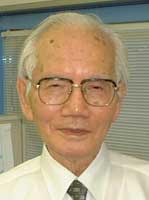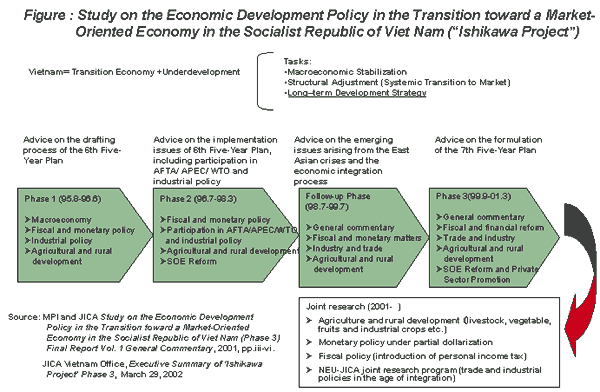Vietnam's Industrialization Strategy in the Age of Globalization
The Ishikawa Project
(Study on the Economic Development Policy for the Transition
toward a Market-Oriented Economy in the Socialist Republic of Vietnam)
 The project was officially agreed upon by the two governments when former Communist Party General Secretary Do Muoi visited Tokyo in April 1995. The Japan International Cooperation Agency (JICA) and the Vietnamese Ministry of Planning and Investment (MPI, previously the State Planning Committee) were the implementing bodies; and Shigeru Ishikawa, professor emeritus of Hitotsubashi University was appointed as the leader on the Japanese side. The project was implemented jointly by the Vietnamese and Japanese teams over six years (in 3 main phases plus additional studies, from August 1995 to March 2001) and covered various areas including agriculture and rural development, trade and industry, fiscal and monetary issues, SOE reform and SME development (see Figure below).
The project was officially agreed upon by the two governments when former Communist Party General Secretary Do Muoi visited Tokyo in April 1995. The Japan International Cooperation Agency (JICA) and the Vietnamese Ministry of Planning and Investment (MPI, previously the State Planning Committee) were the implementing bodies; and Shigeru Ishikawa, professor emeritus of Hitotsubashi University was appointed as the leader on the Japanese side. The project was implemented jointly by the Vietnamese and Japanese teams over six years (in 3 main phases plus additional studies, from August 1995 to March 2001) and covered various areas including agriculture and rural development, trade and industry, fiscal and monetary issues, SOE reform and SME development (see Figure below).
- Basic principle: The "Ishikawa Project" is highly unique in its long-term orientation, compared to the approach by the IMF and the World Bank. As the project was initiated, three main tasks of the Vietnamese Government were identified: (i) macroeconomic stabilization; (ii) structural adjustment (systemic transition to a market economy); and (iii) the design and implementation of long-term development strategy. In the project, the highest priority was given to the third task of long-term development. This is partly because the former two tasks had already been supported by the IMF and the World Bank and the Vietnamese authorities had recognized and begun responding to these challenges. But more importantly, it was because the problems faced by Vietnam were fundamentally different from those of Russia and Eastern Europe where industrialization had been achieved to a large extent under the previous communist governments. In Vietnam, by contrast, the economy remained seriously underdeveloped, and its main task was not systemic transition but economic development. Therefore, strong emphasis was placed on the task of long-term development and poverty reduction through industrialization. Attention was also paid to the appropriate role of the government in the development process.
- Approach and methodology: Based on the above principle, main
research topics were selected and task forces were organized. Each task
force provided policy options, based on the deep understanding of the
existing situations and constraints of Vietnam which were assessed through
intensive field surveys and quantitative analyses. The experience of Japan
and other East Asian countries, especially P. R. China, was frequently
referred to. Moreover, major efforts were made in assisting the drafting
process of the Sixth Five-Year Plan 1996-2000; providing timely advice on
the implementation issues of the Sixth Five-Year Plan and other emerging
issues (e.g., the AFTA deadline of 2006 and WTO entry negotiations, response
to capital account and financial liberalization in light of the Asian crisis
in July 1997); and assisting the formulation of the Seventh Five-Year Plan
2001-2005 and the Ten-Year Strategy for 2001-2010.
- Team composition: From the Japanese side, about twenty academics
participated in the research team, and almost the same number of government
officials was involved from the Vietnamese side. At various stages of
research planning, implementation, and analysis of policy options, intensive
discussions were held so that both sides could gain sufficient understanding
of the issues and reach consensus.
The "Ishikawa Project" is a good example of Japan's intellectual ODA that shows the Japanese development approach based on long-term orientation and real-sector concern. The project made important contributions in three areas: (i) advice on strategic policy options for the long-term development agenda; (ii) production of various academic research papers including analytic assessment and key development issues facing Vietnam; and (iii) technical assistance to Vietnamese policy makers in research methodology and Japan's development approach, through a collaborative process. While the project was completed in March 2001, most of the task force activities have developed into independent, joint research projects. Greater emphasis is put on the design and implementation of concrete measures, which are necessary for Vietnam to reach the targets of the development vision as envisaged in the Seventh Five-Year Plan and the Ten-Year Strategy.
The project was officially agreed upon by the two governments when former Communist Party General Secretary Do Muoi visited Tokyo in April 1995. The Japan International Cooperation Agency (JICA) and the Vietnamese Ministry of Planning and Investment (MPI, previously the State Planning Committee) were the implementing bodies; and Shigeru Ishikawa, professor emeritus of Hitotsubashi University was appointed as the leader on the Japanese side. The project was implemented jointly by the Vietnamese and Japanese teams over six years (in 3 main phases plus additional studies, from August 1995 to March 2001) and covered various areas including agriculture and rural development, trade and industry, fiscal and monetary issues, SOE reform and SME development (see Figure below).
